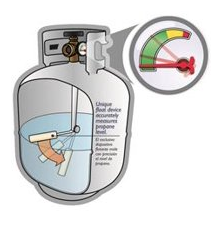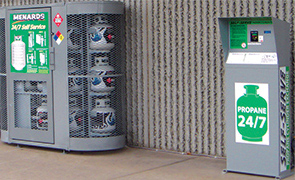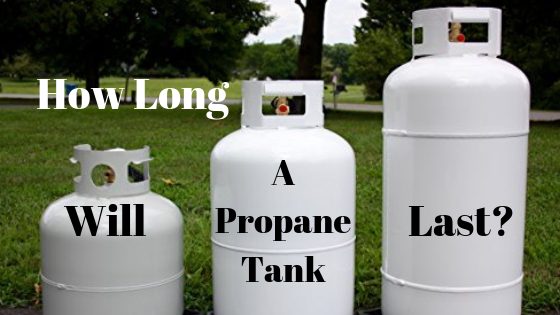Thanks for your support! If you make a purchase using our links in this article, we may make a commission. And, as an Amazon Associate, I earn from qualifying purchases. See the full disclosure here.
Updated April 8, 2024
Ever wonder how long your RV propane tank will last? I have. In fact, we use a propane fireplace to heat our home’s basement. I’ve run out of propane before while RVing and at home, and every time, I wished I knew how long the propane would last before it ran out.
Worse yet, some propane tanks have no gauge! You can pick them up and feel how heavy they are, guess how much propane is left, and then poof—the flame on your gas grill, water heater, or stovetop is out!
Actually, it just happened to us recently, so it made me wonder how long does a propane tank last? The answer is that a gallon of propane will last about 95 hours if burned at a rate of 1000 BTUs per hour. For example, if you have a cooktop with a BTU rating of 30,000 BTUs, then a gallon of propane will last 3.17 hours.
There are other factors to consider when calculating how long a propane tank will last, like the tank size and the BTU rating of the furnace, stove, or water heater you are using. But one thing is for sure—running out of propane is no fun.
So read on for a comprehensive understanding of propane gas, tanks, appliances, BTUs, costs, refill locations and even a link to a handy propane burn time calculator.
What is Propane?
Propane, also called LP or Liquid Propane, is a liquefied petroleum gas or LPG. Propane is most commonly separated from natural gas, then compressed and stored as a liquid inside a propane tank. Propane gas is colorless, odorless, and non-toxic.
The propane odor that you smell is actually a chemical called ethyl mercaptan. It smells like rotten eggs and is added to liquid propane, so you can smell it if it leaks. And it stinks, but that’s the idea, I guess.
Propane is used for all sorts of purposes, including heating, cooking, water heating, generator fuel, and as a power source for LP refrigerators. It weighs 4.125 lbs per gallon.
What’s The Difference Between Propane and Natural Gas?
Natural gas consists mostly of methane. It also contains propane, butane, and a few other gases too. Natural gas comes from underground shale deposits. Many folks have heard of the controversial method called fracking to release gas from the underground. So, propane is actually refined natural gas.
It burns cleaner and hotter than natural gas, so it is considered a much more efficient gas fuel. Propane is also much more available than natural gas because it’s easy to store in tanks and transport after it is liquified.
For example, propane can be delivered by truck to a remote home without natural gas lines. And propane tanks are commonly stored on RV’s for heat, hot water and running the fridge.
Natural Gas vs. Propane
Natural gas is cheaper than propane, but propane burns hotter, cleaner, and is way more available than natural gas. Propane actually produces twice as much heat as an equal amount of natural gas. So, for RVers, boondockers or folks living off the grid, propane is the fuel of choice.
For homeowners with natural gas lines available, it is cheaper to heat your home with natural gas, so in that case, natural gas is the better alternative.
Typical Tank Sizes for RVs
There are two types of propane tanks found on RVs: DOT cylinders and ASME tanks. Both DOT and ASME tanks are made in three very popular sizes for use on RVs: 20, 30 and 40-pound tanks.
There are larger tank sizes too, like 100, 250 and 500-pound tanks, but tanks this big aren’t really meant to transport.
DOT cylinders are used on towable RVs like fifth wheels, travel trailers, truck campers, and sometimes smaller motorhomes. These tanks are approved by the Department of Transportation (DOT).
DOT cylinders are removable or replaceable if qualified. They are mounted on the exterior of a trailer in its exterior compartments or in propane tank holders located on the tongue or bumper of a trailer.
ASME tanks are commonly used in motorhomes and are approved by the American Society of Mechanical Engineers (ASME). These tanks are not removable and are built onto the frame of a motorhome. Therefore, they need to be refilled in place.
How Many Gallons of Propane in a 20 Pound Tank?
A 20-pound propane tank is the most common size tank. A 20 lb tank is typical for barbecue grills, turkey fryers, and small space heaters. I use my 20 lb tank to fuel my portable generator because it’s small and light.
A 20 lb propane tank holds 4.5 gallons of propane, and when full it weighs 36 pounds. A 20 lb tank will fuel my 7500W generator for 10-11 hours straight.
How Many Gallons of Propane in a 30-Pound Tank?
A 30-pound propane tank is typical for RVs and camper trailers. They supply gas for refrigerators, furnaces, water heaters, and stove burners. A 30-pound tank holds 7 gallons of propane, and when full, it weighs 54 lbs.
How Many Gallons of Propane in a 40-Pound Tank?
A 40-pound propane tank is used for large RV’s. A 40 lb propane tank holds 9.4 gallons of propane; when full, it weighs 71 lbs.
How Much Does an Empty Propane Tank Weigh?
- An empty 20 lb propane tank weighs about 17 lbs.
- An empty 30 lb propane tank weighs about 25 lbs.
- An empty 40 lb propane tank weighs about 32 lbs.
How Can I Make My RV Propane Last Longer?
Installing an RV skirt is a great way to make your RV propane last longer, especially when running the heat in winter. RV Skirting keeps the underside of your RV warmer in winter by insulating the air under your RV and keeping the wind from blowing under your RV.
You will save a lot of propane, and money, by investing in a good RV Skirt. We think the very best RV Skirting solution for your RV is AirSkirts. Airskirts has a ton of benefits when compared to conventional or DIY RV skirting, such as:
- Superior Insulation from Cold and Heat
- No Modification or Installation Needed on Your RV
- You Can Set it Up in Under 30 Minutes
- AirSkirts Stays in Place in Snow, Wind, and Rain
- More Affordable than traditional Snap-on RV Skirts
- Military-Grade Construction Makes it Incredibly Durable
AirSkirts will protect the underside of your RV from freezing pipes, heat or cold loss, and damage from the elements. They use air as an insulator, increasing heat or cold retention up to 75% greater than traditional skirts. And, AirSkirts work all year round, saving you money in warm weather as well!
How Long Does Propane Last?
This is the million-dollar question. If you know how long your propane will last, you will know exactly when to refill it. And it’s tough to know exactly how many BTU you are using to accurately predict when your tank will be empty.
However, if you want to geek out and try to calculate your propane usage by appliance type and come up with an estimate, there is a helpful tool called a propane use calculator that is very convenient.
It’s straightforward to use. Just enter the size of your tank and the BTU rating of your appliance, such as a water heater or furnace, and it will calculate the approximate burn time of the propane.
But there are so many other variables to consider that it will take some additional thought to develop a good guesstimate for how long your propane will last.
We have a 25-lb propane tank on our Class A RV. It runs our water heater and cooktop stove. We also have an external propane quick connect that we use for our grill and firepit. To give you an idea, we can run all these appliances for about a month on a propane tank.
What About Propane Tank Gauges?

Most DOT type propane tanks typically do not come with a gauge. But that is changing. There are now 20, 30, and 40 lb propane tanks on the market with built-in gauges, so you know how much propane you have.
The built-in gauge used in these tanks measures the amount of liquid propane in the tank. So, it’s not the type of gauge you can just screw onto an existing tank. The cost is very reasonable too. For example, a typical 20 lb tank without a gauge costs around $30, and a 20 lb tank with a gauge costs around $45.
There are also gauges that can screw onto an existing propane tank and some act as a leak detector and a gauge all in one. It’s a very inexpensive way to keep track of your propane levels and make sure you don’t have a leak in the system somewhere. And you don’t have to buy a new propane tank.
ASME propane tanks typically have a built-in gauge as described above. The indicator is attached to a float inside the gas cylinder that measures the amount of liquid propane in the tank.
New Safety Feature for RV Propane Tanks – Gas Stop
A new RV propane tank safety feature has hit the market in the last couple of years called GasStop. GasStop is the only safety shut off valve for bottled and portable propane systems with ACME or POL type connections. If you have a leak, GasStop will automatically stop the flow of propane.
How Many BTU Per Gallon of Propane?
Each gallon of propane is equivalent to approximately 92,000 BTUs. So, if your furnace unit operates at 30,000 BTUs, it can run for just a little over 3 hours per gallon of propane. But your furnace doesn’t need to run for three hours straight to keep you warm.
It might only need to run for a total of 8 minutes each hour to keep you warm. That means the furnace will kick on for 2 minutes, about every 15 minutes. At that rate, one gallon of propane will heat your RV for about 24 hours. And since a 20-gallon propane tank holds 4.5 gallons, it will heat your RV for 4 and a half days.
Propane Cost Per Gallon
Propane is a commodity, like gasoline, heating oil, coffee or corn. So this means that its price is affected by market forces like seasonality, supply, and demand. An example of seasonality is the price of propane, which will be higher in winter because people need propane to keep warm.
Supply and demand are pretty simple to understand, but in summer, there isn’t much need for propane, so the supply builds up. This means the price of propane will be lower because propane is plentiful. But if there is a shortage of propane, then the cost would be higher because there wouldn’t be enough propane to meet the demand.
And just like crabs in Maryland, when people want something in limited supply, they are willing to pay more for it. And prices will rise.
All that being said, the average cost for a gallon of propane at a refill location ranges between $3.25 and $4.50. The average price at a propane tank exchange location ranges from $5.00 to over $6.00 per gallon. Here is a link to the U.S. Energy Information Administration website, which shows the average price per gallon of propane every week going all the way back to 1990.
In the early 1990s, a gallon of propane was around 90 cents per gallon, and today it’s about $3.25 per gallon. But remember – refill stations for RVs charge a premium over the average propane price to cover the propane tank’s cost and the attendant who must re-fill your tank for you.
RV Propane Filling Stations Near Me
If you are wondering where to get propane or where I can fill my propane tank, there are many locations all across the country to refill or exchange your propane tank. If you have an ASME tank, which is built into your RV, then you need to go to a refill location near you.
However, if you have a DOT tank, then you can go to a refill location or you can exchange your empty tank for a full one at a tank exchange location.
Tank Refill Locations
Tank refill locations can be found at gas stations, RV repair garages, campgrounds, U-Haul, Amerigas and many others. You can also download a free app called Alternative Fueling Stations to find propane refill locations very easily. Just type in the type of fuel (propane) and zip code, and it will find many refill locations near you.
Many spots indicated on the map are U-Haul locations. That’s because U-Haul has the largest network of propane filling stations in the USA. Most locations are open 7 days a week. Also, you don’t need to worry about how to refill a propane tank. An attendant at the refill location will fill your tank for you.
Tank Exchange Locations

If you have a DOT gas tank, then you can take your tank to a refill location and have it refilled or go to a tank exchange location. It’s much cheaper to refill your tank than it is to exchange your tank. The exchange price is pretty high at $4 to $5 per gallon. But it’s also easy to exchange a tank so you pay for the convenience.
Here is an example of how to figure out the price per gallon of a tank exchange. If a tank exchange costs 18.00 and holds 15 pounds of propane, you are paying $4.95 a gallon.
Here is how the math breaks down. A gallon of propane weighs 4.125 lbs. So 15 pounds of propane divided by 4.125 lbs equals 3.64 gallons. And $18.00 divided by 3.64 gallons equals $4.95 per gallon. Yikes!
There are many popular locations to exchange a propane tank, such as Home Depot, Costco, Menards, and Walmart. In fact, some locations have an unmanned kiosk where you can swap propane cylinders 24 hours a day 365 days a year. So, like I said, it’s very easy and convenient to swap out your tanks.
Related Questions
1. How to Dispose of 1lb Propane Cylinders (or any size tank)
Many RVers and campers use 1 lb propane canisters for camp stoves or lanterns. But where can you dispose of them once the propane is used up? Is there a propane tank disposal at Home Depot? No there is not.
You can exchange a 20 lb tank at Home Depot, but there is nowhere to dispose of a 1 lb propane tank. The best method I have found to dispose of any size propane tank is to log onto the Earth911 website. Under the SEARCH FOR box, enter propane tank, and next to that, enter your zip code.
The site will then give you a list of places that accept propane tanks for disposal. The list was long and extensive in my area, so hopefully, plenty of locations will take propane tanks in your area, too.
2. Does Propane Go Bad Over Time?
No, propane does not go bad over time. Since propane is stored in a tank, nothing comes in contact with it, which could cause it to go bad. The only exception to that is the propane tank itself.
The tank could go bad before the propane does because, over time, an old tank may rust through. So, keep your tank in good shape, and it (and your propane) will last a good long time.
Learn More:
– RV Propane Not Flowing? How To Troubleshoot and Solve
– RV Water Heater Not Getting Hot Enough!
– Is It Ok to Drive an RV with the Propane On?
– How Much Propane Does An RV Water Heater Use?
– How Long Will an RV Fridge Run on Propane?
To see a full list of all of our articles check out the Blog Archive!
Thanks for reading our article. Do you have any thoughts to share about how long a propane tank lasts? Please share your comments below.
If you would like to contact us directly, please feel free to visit our Contact Page to send us an email.
Mike Scarpignato – Bio
Mike Scarpignato created RVBlogger.com over five years ago in 2018 to share all we have learned about RV camping.
Mike is an avid outdoorsman with decades of experience tent camping and traveling in his 2008 Gulf Stream Conquest Class C RV and 2021 Thor Challenger Class A motorhome.
We attend RV Shows and visit RV dealerships all across the country to tour and review drivable motorhomes and towable trailers to provide the best evaluations of these RVs in our blog articles and YouTube videos.
We are 3/4-time RVers who created RVBlogger.com to provide helpful information about all kinds of RVs and related products, gear, camping memberships, tips, hacks and advice.



Mike & Susan, your site and comments are always helpful.
Thanks,
Jim L
Thanks Jim!
We appreciate the very kind words.
Thank you for the great information in this article! I found especially helpful the app to find the alternate sources of fuel, I’ve been using google maps this whole time and it has been un-reliable!
This was great!
This is a really interesting article.
I’ve shared your site in my social networks!
Hi Alice,
I’m glad you liked the article and I really appreciate you sharing the site with your social network!
We need all the help we can get with spreading the word about our website!
Thanks very much!
Mike